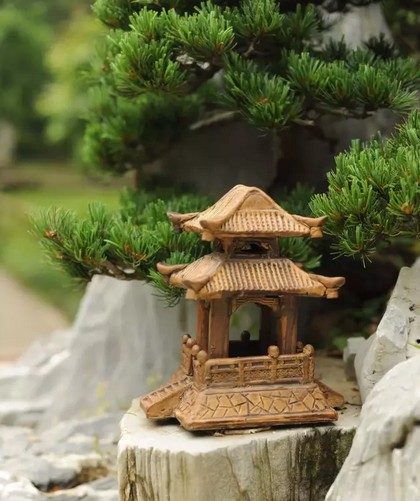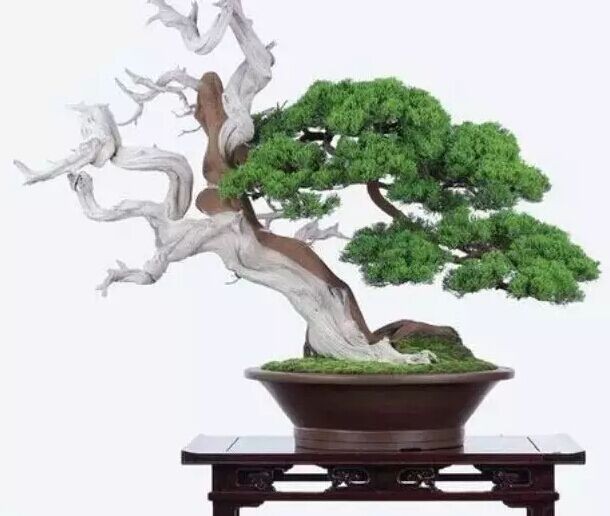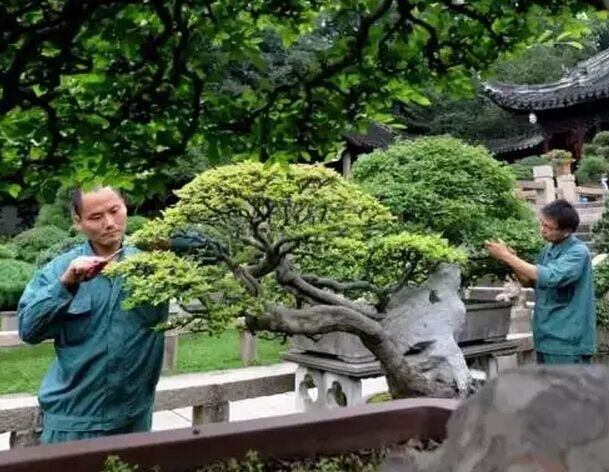About Su-style bonsai
Su-style bonsai is famous for its quaint elegance and simplicity. For decades or even hundreds of years, Qiu Gan old branches, cultivated in a small basin, are unexpectedly tall. The second feature of Su style bonsai is its fine production and dexterity, just like the silk and bamboo music in the south of the Yangtze River, giving people an elegant, beautiful, pleasant and smooth feeling. Bonsai is known as "three-dimensional painting" and "silent poetry".

Suzhou is located on the shore of Taihu Lake, with beautiful mountains and green waters, beautiful scenery, humid climate and abundant rainfall, so there is a rich variety of plants available for bonsai production. Suzhou is also rich in all kinds of rocks suitable for landscape bonsai, such as transparent and exquisite Taihu Lake Stone, Kunshan Baibai, Suzhou Huangshi and so on. This provides sufficient material conditions for bonsai production.
Suzhou, which has been founded for 2500 years, is also an area with a gathering of humanities, prosperous culture and famous poems, books and paintings. Wei Yingwu, Bai Juyi and Liu Yuxi all made the history of Suzhou thorns in the Tang Dynasty. After the Song and Yuan dynasties, there were more poets and poets who came from or once lived in Suzhou, and they left a lot of poems and pictures to Suzhou. Bonsai is full of poetic works of art, these poems, articles, pictures, have become the source of creative ideas for bonsai artists.
The four painters who had a great influence on Suzhou bonsai style were Shen Shitian, Wen Zhengming, Tang Bohu and Qiu Shizhou during the Chenghua and Hongzhi years of the Ming Dynasty, which were called "Wumen painting School" in later generations. Suzhou scholars of successive dynasties made bonsai, including Fan Chengda in Song Dynasty, Wen Zhenheng in Ming Dynasty, Hu Huanzhang in Qing Dynasty, Zhou slim Juan in modern times, and so on. Mr. Zhou once said, "my bonsai is created on the one hand and modeled on the famous paintings of the ancients on the other hand." He has made bonsai by imitating Tang Bohu's Banana Stone Picture, Xia Zhongzhao's Bamboo interest Picture and half window Qingcui Map, and Wang Yanke's Xinpu Shou Stone Picture in the Qing Dynasty.
Su-style bonsai is based on tree stump bonsai, and the materials used can be divided into two categories: one is deciduous trees and the other is evergreen trees. The main deciduous tree species are Yingchun, begonia, pomegranate, plum blossom, wisteria, etc.; those who view roots, branches and leaves are elm, triangular maple, red maple, sparrow plum, yellow poplar and so on. Evergreen trees are mainly camellia, rhododendron, tiger thorn, gardenia, southern bamboo, Chinese wolfbone, sweet-scented osmanthus, as well as black pine, five-needle pine, Luohan pine, pomelo, real cypress, juniper, bamboo, rice leaf holly and so on.
Before the founding of New China, there were many rules and regulations in Suzhou bonsai production, and each tree often had to be tied into ten pieces of "six sets, three supports and one item" before it could be called bonsai. This is to leave three side branches on the left and right sides of the tree trunk, and when it grows slowly, tie three pieces on each side, that is, "six sets"; then tie it into three pieces, that is, "three supports"; and finally tie the top into one piece, that is, "one top". These ten pieces are all made of brown silk into a round shape, which takes more than ten years, which is not only time-consuming, but also overly artificial and unnatural.
In the late 1950s, Zhou slim Juan and veteran artists Zhu Zian, Zhang Shijin and others. It is advocated that bonsai should be based on natural beauty and oppose affectation. Before the trees sprouted at the end of early spring, they collected old tree stumps from the mountain forests in the suburbs, planted them in pots, and placed them in a sunny leeward or greenhouse to maintain a certain degree of humidity. after sprouting into branches, they would cut and tie along with them, and they would take shape in autumn. This is the rapid cultivation method they created, which was excavated, cultivated, cut and shaped in that year, and appreciated in that year. With this method of cultivating bonsai, bonsai is made in different forms and is more natural and beautiful. At the same time, in the technique, it set a precedent of taking scissors as the main and tie as the auxiliary, changing the past method of using pruning as the main method and shearing as the auxiliary. This more advanced method of coarse binding and fine shearing has won the approval of experts all over the country. At that time, 22 large and medium-sized cities, such as Beijing, Tianjin, Jinan, Yantai, Qingdao, Lanzhou, Xi'an, Lintong, Wuhu, Hefei, Guilin, Jingdezhen, and so on, sent horticulturists to the Suzhou Landscape Management Office to study the "bonsai rapid cultivation method."
Time: 2019-06-04 Click:
- Prev

Suzhou bonsai and its style characteristics
Suzhou bonsai, commonly known as Suzhou School, is a type of bonsai art style named after Suzhou. It centers on Suzhou and extends to many areas south of the Yangtze River, such as Changshu, Wuxi, Changzhou and so on. The representative figures are Zhou Lianjuan, Zhu Zian and so on. Su style bonsai is mainly based on tree bonsai, paying attention to nature, and the type changes with the pile.
- Next

Pruning "Beauty" in Meiyu season presents the unique artistic charm of Su style bonsai.
During the Meiyu season, Rain Water has a lot of humidity, the plant growth is particularly exuberant, and the branches and leaves of the bonsai stump grow very fast. Yesterday, the gardener of the Wanjing Villa bonsai garden in Huqiu took advantage of the weather and rain to trim and beautify more than 600 pots of Su-style bonsai in the garden, so that these boutique bonsai can grow healthily and maintain a beautiful shape all the time.
Related
- Fuxing push coffee new agricultural production and marketing class: lack of small-scale processing plants
- Jujube rice field leisure farm deep ploughing Yilan for five years to create a space for organic food and play
- Nongyu Farm-A trial of organic papaya for brave women with advanced technology
- Four points for attention in the prevention and control of diseases and insect pests of edible fungi
- How to add nutrient solution to Edible Fungi
- Is there any good way to control edible fungus mites?
- Open Inoculation Technology of Edible Fungi
- Is there any clever way to use fertilizer for edible fungus in winter?
- What agents are used to kill the pathogens of edible fungi in the mushroom shed?
- Rapid drying of Edible Fungi

